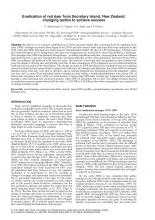Eradication of red deer from Secretary Island, New Zealand: changing tactics to achieve success

Island and Ocean Ecosystems
Available Online
Edge, K.A.
,
Macdonald, N.
,
Nugent, G.
,
Parkes, J.P.
2019
Red deer (Cervus elaphus) established on 8,140 ha Secretary Island after swimming from the mainland in the early 1960s. Attempts to remove them began in the 1970s and after several starts and stops they were eradicated in late 2014. Since late 2006, 688 deer have been removed. Ground hunters killed 365 deer in 1,827 hunter-days, 320 deer were shot from helicopters in 211 ?ying-hours, two deer were trapped and one was known to have been killed by a ?sherman. The campaign since 2006 was planned in three phases an initial population reduction, a mop-up phase and a surveillance and rapid response to any new immigration phase. An initial reduction of 80% of the population, between 530 and 550 in 2006, was planned and achieved in the ?rst two years. The removal of surviving deer was planned to take a further four years but despite 114 being shot and probably less than 14 deer remaining in 2013 eradication was not achieved using the methods that succeeded in the initial phase. The change in tactics in 2014 that allowed for eradication was to (a) ground survey the island and use camera traps to locate areas with deer, (b) identify individual deer from faecal DNA to estimate numbers, know when they were shot or still alive, and to estimate potential new immigration from the mainland which was low, and (c) move from individual hunters seeking any deer within a widespread population, when about 10% of hunter-deer encounters led to a kill, to re-train hunters as teams using GPS/radio systems and integrate them with aerial hunting to seek individual deer at known locations, when 100% of encounters led to a kill. The change of tactics that led to eradication success required about half the costs, i.e. $25,000 to $10,500 per deer direct operational costs, expected if no change had been made.
